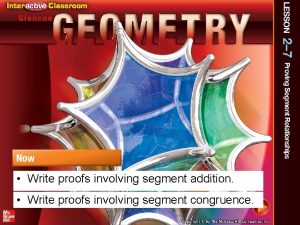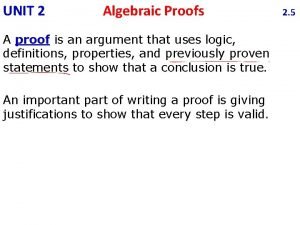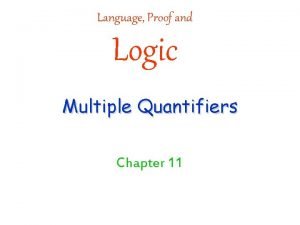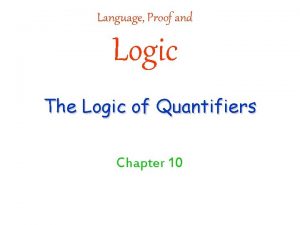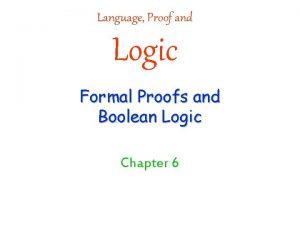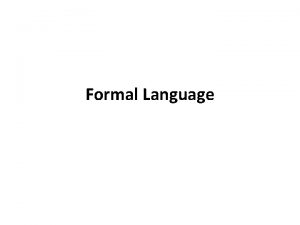Language Proof and Logic Formal Proofs and Quantifiers




![13. 3. b Strategy and tactics x[Tet(x) Small(x)] x[Small(x) Left. Of(x, b)] x. Left. 13. 3. b Strategy and tactics x[Tet(x) Small(x)] x[Small(x) Left. Of(x, b)] x. Left.](https://slidetodoc.com/presentation_image_h/f3e384d46c3ccc27a5566280d3f5662d/image-5.jpg)

- Slides: 6

Language, Proof and Logic Formal Proofs and Quantifiers Chapter 13

13. 1 Elim: Universal quantifier rules x t c --- variable --- constant term (variable-free term) --- constant which does not occur outside the subproof where it is introduced P(x), Q(x) --- any wffs only containing x free P(c), Q(c) --- the result of replacing in P(x), Q(x) all free occurrences of x by c P(t) --- the result of replacing in P(x) all free occurrences of x by t x. P(x) … P(t) Intro (General Cond. Proof): c P(c) … Q(c) x[P(x) Q(x)] Intro (Universal introduct. ): c … Q(c) x. Q(x) You try it, pp. 353, 354 [Universal 1 -2]

13. 2 Existential quantifier rules Intro: Elim: P(t) … x. P(x) … c P(c) … Q Q x. P(x) x --- variable t --- constant term (variable-free term) c --- constant which does not occur outside the subproof where it is introduced P(x) --- any wff only containing x free P(c) --- the result of replacing in P(x) all free occurrences of x by c P(t) --- the result of replacing in P(x) all free occurrences of x by t You try it, pp. 358 [Existential 1]

13. 3. a Strategy and tactics General tips: 1. Always be clear about the meaning of the sentences you are using. Practically zero chance to succeed without that! 2. A good strategy is to find an informal proof and then try to formalize it. 3. Working backwards can be very useful in proving universal claims. You typically use Intro in these cases. 4. Working backwards ( Intro) is not useful in proving an existential claim x. S(x) unless you can think of a particular instance S(c) of the claim that follows from the premises. 5. If you get stuck, consider using proof by contradiction.
![13 3 b Strategy and tactics xTetx Smallx xSmallx Left Ofx b x Left 13. 3. b Strategy and tactics x[Tet(x) Small(x)] x[Small(x) Left. Of(x, b)] x. Left.](https://slidetodoc.com/presentation_image_h/f3e384d46c3ccc27a5566280d3f5662d/image-5.jpg)
13. 3. b Strategy and tactics x[Tet(x) Small(x)] x[Small(x) Left. Of(x, b)] x. Left. Of(x, b) Informal proof: Look, Bozo, we are told that there is a small tetrahedron. So we know that it is small, right? But we’re also told that anything that’s small is left of b. So if it’s small, it’s got to be left of b, too. So, something is left of b, namely, the small tetrahedron. You try it, p. 366 [Quantifier Strategy 1] Formal proof: 1. x[Tet(x) Small(x)] 2. x[Small(x) Left. Of(x, b)] 3. c Tet(c) Small(c) 4. 5. 6. 7. Small(c) Left. Of(c, b)] Left. Of(c, b) x. Left. Of(x, b) 8. x. Left. Of(x, b) Elim: 3 Elim: 2 Elim: 4, 5 Inro: 6 Elim: 1, 3 -7

13. 4 Soundness and completeness As in the propositional case, we have: Q is provable in Fitch from premises P 1, …, Pn if (completeness) and only if (soundness) Q is a FO consequence of P 1, …, Pn
